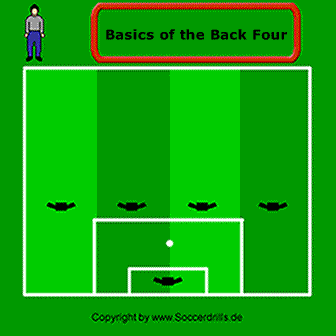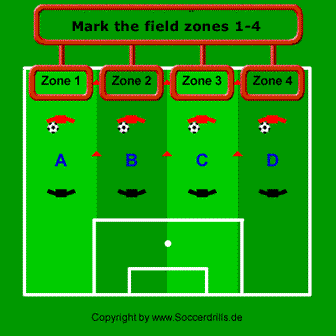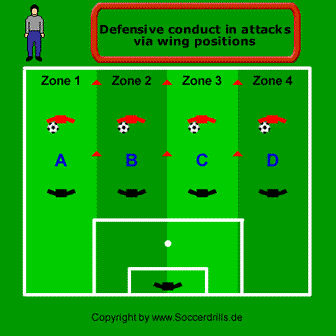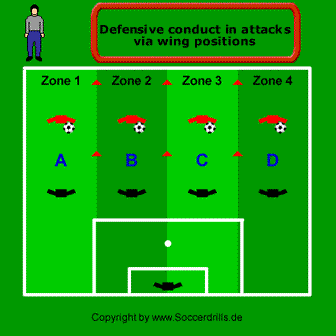→ Next - Practice Examples (2)
Practice Examples (1)
1. Introduction – entry into the back four
The introduction of the back four (ball-oriented defence) means: The entire team moves in direction of the ball, not only the back four defenders, whereby the goalkeeper gets particular importance. He can run for the balls which are being hit into the back space of the back four and serves as open man after ball-winning.

1
Graphics back four – static
The purpose is to constantly act superior in number near the ball. The principle is: The closer the opponent is to the ball, the tighter the cover; and the farther away an opponent is from the ball, the less dangerous he is.
In this paper we explain the fundamentals for the introduction of the back four within the defence network. The individual presentations are briefly touched on theory-wise and subsequently broadened in the form of drills.
In a further contribution we have put together some preparatory drills that can be incorporated best as warm up in a back four training unit. You will find these drill series soon under “Back Four – Warm Up – Constructive Exercises”.
This presentation comprises drills that project the theoretical part. As a small deepening unit we have furthermore briefly shown the attack by a player without ball.
In order to test the back four in a match, the following starting games are suitable: 2 defenders against 3 attackers, 3 defenders against 4 attackers, 4 defenders against 4 attackers up to playing 11 against 11. The defensive players move in all these drills as a chain.
2. Ball-oriented defence in marked zones
Mark the field zones (see illustration), then following the arrows below the animation.
A. Static zones

2A
Each defender and each attacker is located in as zone. Each attacker has a ball. The zones will be numbered 1 to 4. Take ample time to carefully view the animation.
B0. Orientation against attacker

B0
Please observe: In these next units it is not primarily a question of speed but rather of correct execution. Between instructions sufficient time is required by the defence to get orientated.
B1. Defensive conduct in attacks via wing positions

B1
In our example, the coach gives the signal “1”.
Defender A attacks attacker A. Defenders B, C and D orientate themselves in direction of the ball and keep at the same time an eye on the attacker located in their starting zone.
The sequence in our illustrated example:
- The coach cries the signal “1”.
- Defender A attacks attacker A.
- Defender B moves to zone 1, so as to secure the back space behind defender A. At the same time he keeps an eye on attacker B, to be able to react quickly if need be.
- Defender C advances to zone 2. At the same time he keeps an eye on attacker C, to be able to react quickly if necessary.
- Defender D advances to zone 3. At the same time he keeps an eye on attacker D, to be able to react quickly when indicated.
At this moment, attacker D is of no danger to the defence, hence it can neglect covering the attack side. Should a shift of the attack to the other side of the playing field take place, sufficient time remains for realignment.
If the coach gives signal “4”, an entirely new situation for the defence will occur.